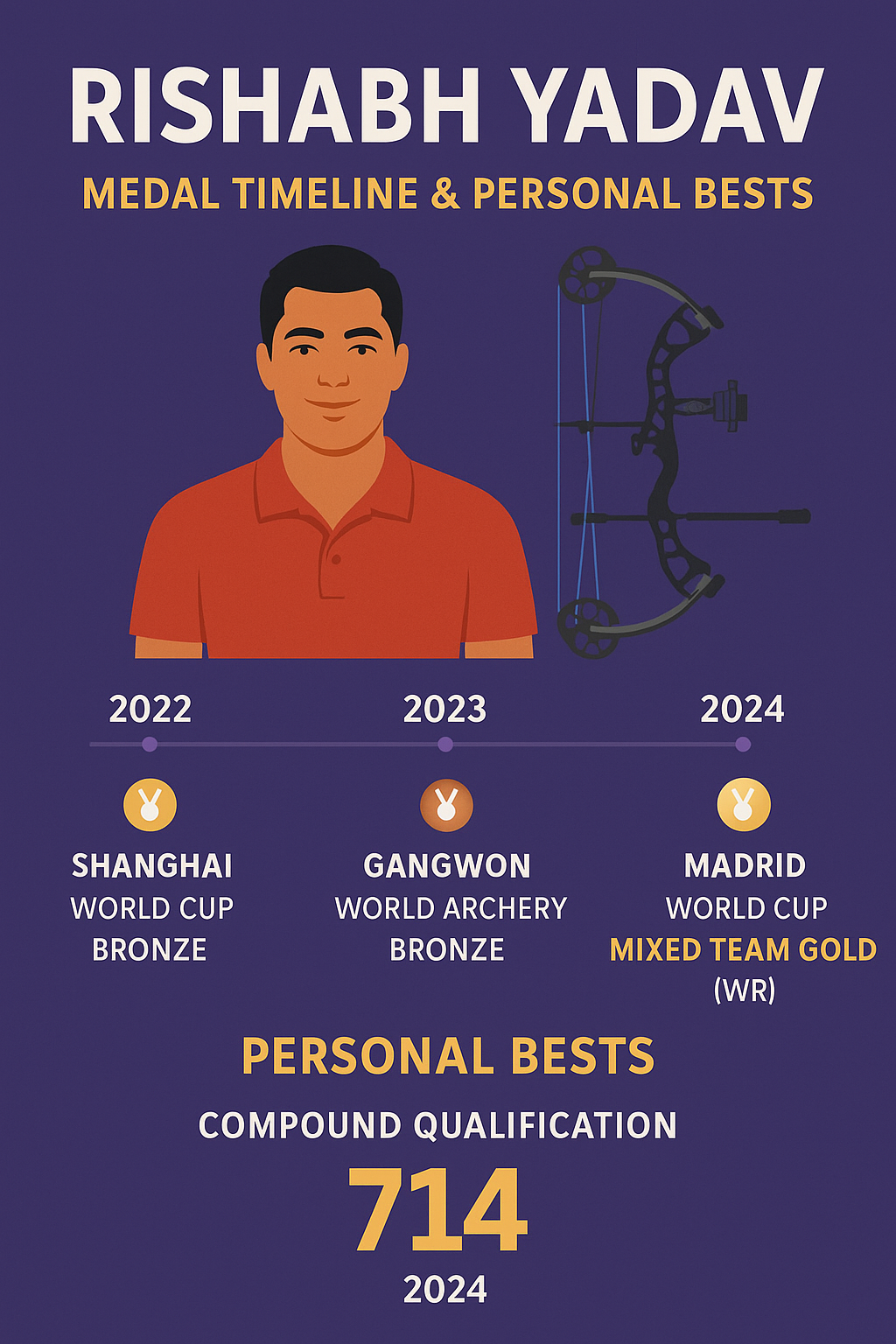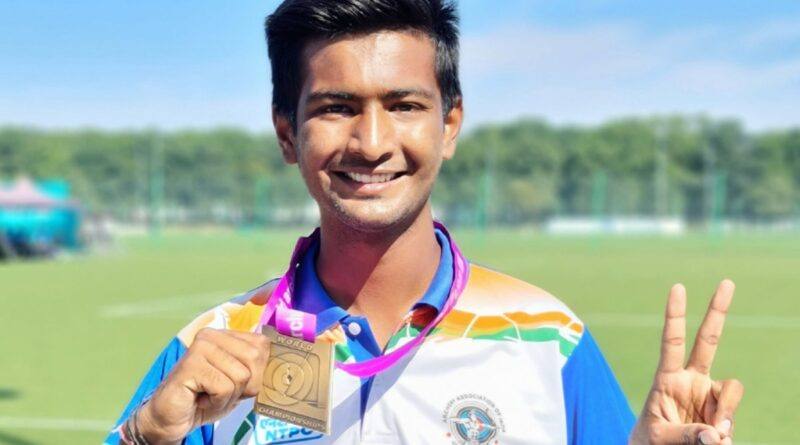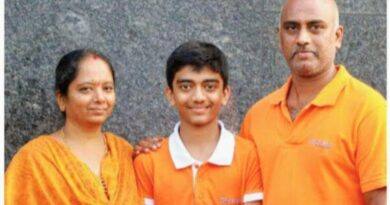This Is The Story Of Rishabh: Making Indian Archery Better
Wilfred Melwyn | Sports | October 2025 Edition
Rishabh Yadav and the Rise of India’s Archery Ambition
A new arrow’s path
In July 2025, at the Archery World Cup in Madrid, Rishabh Yadav and Jyothi Surekha Vennam shot a combined score of 1,431 in the mixed team event, breaking the previous world record of 1,429. (Wikipedia)

It was more than a record. For many followers of Indian sport, it felt like a message: India is no longer just a brute-force cricket nation; it is quietly mastering precision disciplines too.
But it’s not a flash in the pan. Behind that moment lies a longer story of individual grit, institutional shifts, and diaspora influence. In this article, we explore how Rishabh’s ascent signals a turning point for India’s approach to archery, and what that means for sport in the diaspora-redrawn world.

1. The background story
Rishabh Yadav was born in Gurugram, Haryana, in 2002. He entered competitive archery early: by his late teens, he was already making waves at national and continental levels. (Wikipedia) 2025 has been his standout year. He won an individual World Cup bronze in Shanghai, and in Madrid, he became co-holder of a mixed team world record with Jyothi. (Wikipedia) He also competed in the Asian Athletics Championships in Gumi, not as a full-time track athlete, but as part of India’s wider sporting delegation, placing fifth in the javelin throw category. (Note: that involvement indicates his versatility and how select countries concentrate multi-sport delegations.)
What makes his trajectory interesting is that archery is not one of India’s traditional cash-sports (cricket, badminton, and hockey). He has succeeded in relative obscurity, relying on a mix of private coaching, targeted federational support, and the growing professionalism in Indian Olympic sports.
His education has balanced sport and academics: he holds a Bachelor’s degree and is reportedly pursuing an MBA. (Wikipedia) That dual commitment is typical of many diaspora-minded young athletes today, success in sport, but with fallback values in life beyond the arena.
2. The archery ecosystem in 2025, India and beyond
To understand Rishabh’s rise, one must see the changing infrastructure around him.
High-performance funding increase
Over the past decade, India’s National Sports Federations, along with the Ministry of Youth Affairs & Sports, have gradually increased budgets for Olympic and non-traditional sports. Archery today has a more robust pathway: talent identification camps, regional academies, and national-level prize money. That shift means archers no longer rely entirely on private funds.
Global competition intensifies
Archers from Korea, the United States, and Europe have always been powerhouses. But the playing field is tightening. Techniques such as mental conditioning, video analytics of arrow trajectories, and equipment tuning (external stabilisers, materials) are now standard. Rishabh’s record-breaking mixed score was not a fluke, it was enabled by rigorous training and technological support.
Mixed-team events matter
Mixed-team events are now a focal point of archery tournaments. For many countries, they offer a quicker route to medals without needing a full team. Rishabh’s world record in a mixed event places him squarely in India’s strategic view for future international success.
Diaspora influence and coaching
Indian-origin coaching talent and diaspora networks are beginning to cross national boundaries. Athletes based abroad sometimes bring techniques, exposure, or sparring partners back into India’s training ecosystem. This cross-pollination helps reduce India’s relative isolation in high-tech sports.
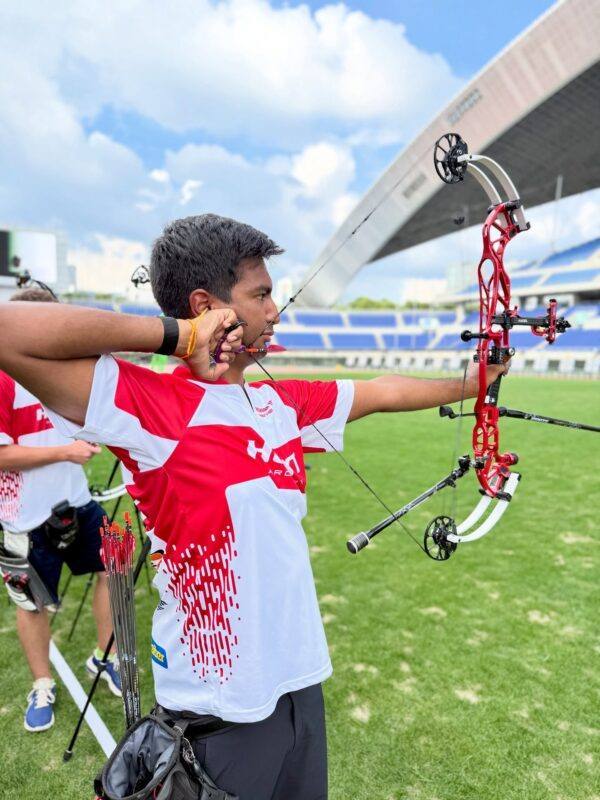
3. What Rishabh’s success says about India’s sporting culture
Many things have changed in how India approaches sports beyond cricket. Rishabh’s example gives us a few lessons:
1. Excellence in niche disciplines is possible
India’s sporting identity is diversifying. Success in niche but global sports, archery, fencing, climbing, is gaining media and institutional attention.
2. Investment matters
Talent often sits buried unless supported. Rishabh’s rise is not just personal; it is a signal that federations are beginning to invest where previously they hesitated.
3. Youth and continuity
Archers have long careers. At 23, Rishabh still has a decade or more ahead. India needs to build systems that not only produce stars but sustain them.
4. Gender balance
Mixed events force equitable gender participation. Rishabh’s pairing with Jyothi Surekha reflect that archery, more than many sports, offers co-equal opportunities in the same event.
5. Export potential
Diaspora markets can become fanbases. If Indian archers perform abroad, they attract global sponsorships, media contracts, and audiences, transforming them from national heroes to global ambassadors.
4. Challenges that still remain
Rishabh’s success does not erase systemic gaps.
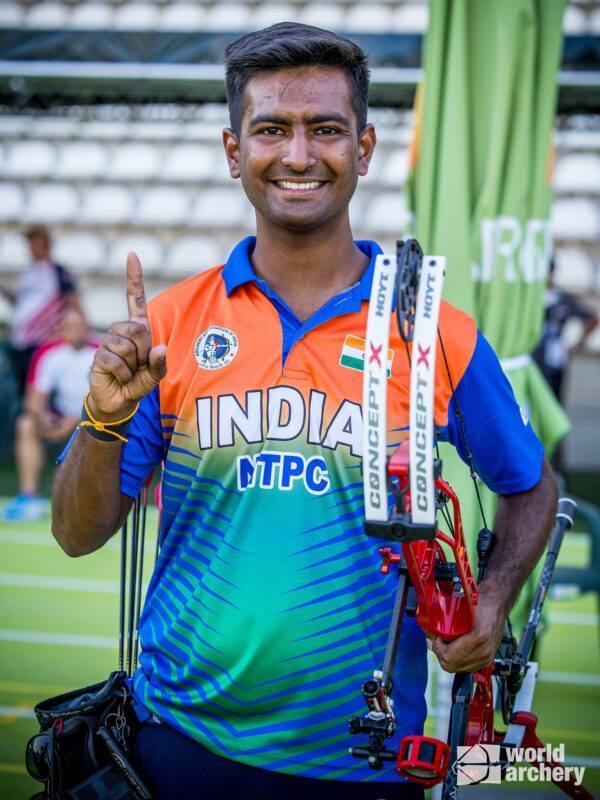
Infrastructure inequality
Many parts of India still lack good archery ranges, quality bows, materials, and coaches. Rural talent finds it especially hard to scale.
Sponsorship scarcity
Corporate sponsorship tends to cluster around cricket, badminton, and football. Athletes like Rishabh often rely on grants and government funding, which can be unstable.
Media visibility
Despite world records, archery remains niche in mainstream media. The few headlines don’t carry much financial or branding weight.
Retention and career transition
Many athletes struggle when their competitive career wanes. Without parallel education or post-sport pathways, many fade from public view.

5. The diaspora dimension
For the Indian diaspora, Rishabh’s story has extra resonance.
- Role model factor: Young Indians living abroad often see limited representation in elite global sports. Rishabh becomes a name they can point to, not just in cricket or tennis, but in precision Olympic disciplines.
- Talent mobilisation: Indian diaspora youth with archery interest may now feel connected to Indian sport rather than local federations only.
- Cultural bridge: Diaspora often desperate for connection to home sees national records, sporting glory, and athlete journeys as threads back to heritage.
- Sponsorship bridges: Global Indian brands may choose to sponsor athletes like Rishabh to reach both Indian and diaspora markets, creating a win-win.
6. What’s next, projections and possibilities?
Road to Olympics and World Championships
Rishabh will aim for consistency in individual events, not just mixed teams. If he can hit scores consistently above 730 in qualification rounds, he becomes a medal contender globally.
Technology and analytics
Heavily data-driven coaching (arrow flight modelling, wind compensation software) will become more critical. Athletes who manage equipment calibration and micro-adjustments will have an edge.
League formats and monetisation
India and other nations are exploring franchise-style archery leagues, where archers earn monthly pay and build fan identities. Rishabh, with his rising brand, may figure prominently.
Diaspora tournaments
Create archery competitions for the Indian diaspora globally, to scout talent, to maintain connection, and to drive investment from diaspora communities into Indian sport.
Governance reforms
Ensuring that federations provide health, insurance, retirement, and mental health support. Athletes like Rishabh should not be left adrift off the podium.
7. The wider context, archery’s place in Indian sport
India has a proud archery history, with names like Deepika Kumari, Abhishek Verma, etc. Rishabh’s rise emerges from that lineage but points to a new chapter, one with more depth, more balance, and more global orientation.
In 2025, India sent 17 athletes to the World Games in disciplines including archery, wushu, roller sports and others. (The Tribune) This suggests India understands that its sporting ambition must go beyond the Olympics. Archery, being an accessible but highly skillful sport, is a natural pillar.
If India continues to nurture athletes in disciplines that demand precision, calm, and longevity, from archery to athletics, shooting to fencing, it can expand its medal portfolio beyond a few traditional strongholds.
8. Aim, Release, Rise
Rishabh Yadav’s world record is more than a statistical feat. It is a signal: India’s sporting ambition is diversifying. The archer’s success reveals that with vision, funding, institutional backing, and diaspora engagement, elite talent in niche sports can emerge and thrive.
For the global Indian community reading this, his victory has layers: it is personal inspiration, national pride, and a thread in the evolving narrative of India’s identity abroad.
The next arrow he fires will not only aim for the target board, it will aim at redefining how India competes in the global arena of sports.
Let’s watch closely.
By Wilfred Melwyn
